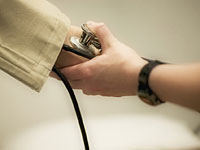



- Viagra
- Sildenafil Citrate (TP)
- Sildenafil Citrate TEVA
- Tadalafil TEVA
- Tadalafil ACCORD
- Tadalafil DAILY
- Vardenafil TEVA
- Vardenafil ZYDUS
- Sildenafil Citrate (GS)
- Cialis
|
Even Slightly High Blood Pressure May Raise Stroke Risk
2011-10-05
|
Even Slightly High Blood Pressure May Raise Stroke Risk

WEDNESDAY, September 28, 2011 (Health.com) — Many more Americans may be at risk of having a stroke than previously thought.
Doctors have long known that high blood pressure, or hypertension, is among the most important risk factors for stroke. Now a new study has found that middle-aged people with blood pressure that’s only slightly above normal—a condition known as prehypertension—are 68% more likely to have a stroke than those with normal blood pressure.
“This shows that prehypertension is not a benign condition,” says John Bisognano, MD, a professor of cardiology at the University of Rochester Medical Center, in Rochester, N.Y., who was not involved in the new research. “Mild elevation of blood pressure is a big deal.”
To reduce their risk of stroke (among other health problems), people with prehypertension should lower their blood pressure by losing weight, curbing their sodium intake, and making other healthy lifestyle changes, says Bruce Ovbiagele, MD, the senior study author and a professor of neurosciences at the University of California–San Diego School of Medicine.
Prescription hypertension drugs are “absolutely not” necessary in this group, Dr. Ovbiagele adds. “There’s no reason to recommend drug therapy in people who fall into the prehypertensive category.”
Hypertension is defined as having systolic blood pressure of at least 140 millimeters of mercury (mm Hg) and diastolic blood pressure of at least 90 mm Hg. (Systolic and diastolic are the top and bottom numbers, respectively, in a blood-pressure reading.)
People with systolic pressure between 120 and 139 mm Hg or diastolic pressure between 80 and 89 mm Hg are said to have prehypertension. An estimated 31% of adults in the United States fall into this category, according to the study, which was published this week in the journal Neurology.
The increased risk of stroke was considerably larger in the upper half of the prehypertension range. Compared to people with normal blood pressure, those with systolic pressure between 130 and 139 or diastolic pressure between 85 and 89 were 79% more likely to experience a stroke, while those in the lower half of the range were just 22% more likely.
Moreover, the link between prehypertension and stroke applied only to adults under the age of 65. When the researchers included seniors in their analysis, the overall risk of stroke associated with prehypertension dropped to 55%.
“We think that’s because age is such a powerful predictor of stroke,” Dr. Ovbiagele says. “It’s associated with so many [risk factors] beyond blood pressure.”
Ovbiagele and his colleagues pooled and analyzed data from 12 previously published studies. Those studies, which date back to 2003, included some 500,000 patients in the United States, China, Japan, and India.
The team’s findings appear to at least partly vindicate the controversial decision by a National Institutes of Health (NIH) panel to create the prehypertension category in 2003. At the time, critics of the decision accused the outside experts who sat on the panel of being unduly influenced by the manufacturers of hypertension drugs.
“People felt that [the experts] were going to classify patients who are otherwise normal as having disease or pre-disease,” Dr. Ovbiagele says. “People thought the reason was for drug companies to put everyone on drugs. There was also no great new scientific evidence showing that these people were actually at a higher risk of strokes or heart attacks.”
Like Ovbiagele, both the NIH and the American Stroke Association, a nonprofit research organization, recommend lifestyle changes—but not drugs—for people with prehypertension.





